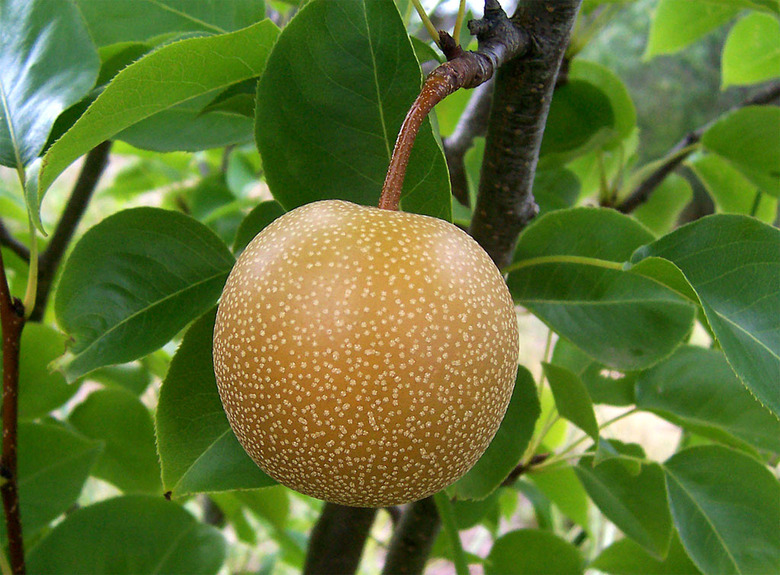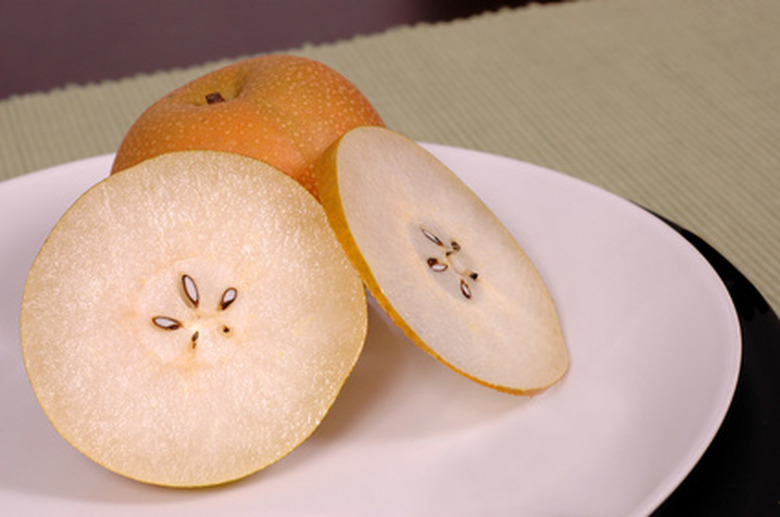Do Asian Pears Ripen After Picking?
Also known as the sand pear and apple pear, the Asian pear (Pyrus pyrifolia) is a variety of pear that ripens on the tree. Therefore, if you would rather not have to ripen pears after harvesting them, Asian pear trees may be the right choice for your garden.
Asian pear trees are winter hardy in USDA plant hardiness zones 5 to 9. Some cultivars are more heat and cold tolerant than others.
Asian Pear Cultivars
Unlike European pears (Pyrus communis, zones 4 to 8), which are what we consider pear-shaped, Asian pears are round like apples, hence the common name "apple pear." They also have textured skin and firm (rather than buttery) flesh. There are a number of cultivars that originated in China, Japan and Korea.
The most widely grown Asian pear cultivar in the U.S. is 20th Century (Pyrus pyrifolia 'Nijisseiki,' zones 5 to 9), which produces medium to large fruit. The Chojuro Asian pear (Pyrus pyrifolia 'Chojuro,' zones 5 to 8) is a popular Japanese pear cultivar distinguished by its butterscotch-like flavor. Unfortunately, both of these cultivars are highly susceptible to a disease known as fire blight.
Most Asian pear trees require cross-pollination by a compatible Asian pear cultivar in order to produce fruit. That means you will usually need to plant at least two compatible fruit trees in your garden to harvest a crop. Even those Asian pear cultivars considered self-pollinating perform better with pollination by another cultivar.
When Is a Pear Ripe?
**It takes Asian pears four to seven months to ripen on the tree.** The ripening time depends on the cultivar. Some Asian pears ripen in August, while others ripen in the fall. The trees bloom in the spring.
It takes Asian pears four to seven months to ripen on the tree.
Color is one of the best indicators that an Asian pear is ripe; **when immature, most Asian pears have green skin that turns yellow when the fruit is ripe.**
A taste test is often needed to confirm that pears are ready to be harvested; ripe Asian pears are sweet and have a crunchy texture. **A pear that is ripe will come off the tree branch easily when you twist it.**
Can You Ripen an Asian Pear After Picking?
One of the main differences between Asian pears and European pears is that European pears ripen after being harvested from the tree. In fact, they will not ripen properly if left on the tree. Asian pears, on the other hand, must ripen fully on the tree, as they do not continue to ripen once they have been picked.
Tip
While European pears ripen after they have been harvested, Asian pears only ripen on the tree.
European pears are harvested unripe and require a period in cold storage before they can be consumed. Asian pears, however, can be eaten right away or stored.
If kept at temperatures between 32° and 35°F, most Asian pears have a storage life between one and three months. The Chojuro Asian pear can be kept for up to five months.
References
- North Carolina State Extension: Pyrus pyrifolia
- Penn State Extension: Asian Pears in the Home Orchard – Variety Selection
- Iowa State University Extension and Research: How to Harvest, Ripen, and Store Pears
- North Carolina State Extension: Pyrus communis
- Utah State University: Growing Pears in the Home Orchard
- North Carolina State Extension: Pyrus pyrifolia 'Nijisseiki'
- North Carolina State Extension: Pyrus pyrifolia 'Chojuro'

